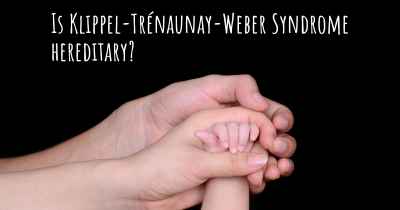What is the life expectancy of someone with Klippel-Trénaunay-Weber Syndrome?
Life expectancy of people with Klippel-Trénaunay-Weber Syndrome and recent progresses and researches in Klippel-Trénaunay-Weber Syndrome

Klippel-Trénaunay-Weber Syndrome (KTWS) is a rare congenital disorder characterized by a triad of symptoms: port-wine stain birthmarks, varicose veins, and abnormal growth of bones and soft tissues. The life expectancy of individuals with KTWS can vary depending on the severity of their symptoms and associated complications. While there is limited data on life expectancy specifically for KTWS, it is generally believed that most individuals with this syndrome have a normal lifespan. However, some cases may experience complications such as blood clots, infections, or organ involvement, which can impact overall health and longevity. Regular medical monitoring and appropriate management of symptoms are crucial to ensure the best possible outcomes for individuals with KTWS.
Klippel-Trénaunay-Weber Syndrome (KTWS) is a rare congenital disorder characterized by a triad of symptoms including capillary malformations (port-wine stains), venous malformations, and soft tissue and bone overgrowth. The severity and extent of these symptoms can vary greatly among individuals, making it challenging to provide a definitive answer regarding life expectancy.
Since KTWS affects multiple systems in the body, it can lead to various complications that may impact life expectancy. The most common complications associated with this syndrome include:
- Deep vein thrombosis (DVT): The abnormal venous system in KTWS can increase the risk of blood clots, particularly in the deep veins of the legs. If left untreated, DVT can lead to serious complications such as pulmonary embolism, which can be life-threatening.
- Chronic pain: Soft tissue and bone overgrowth can cause chronic pain and discomfort, affecting the quality of life for individuals with KTWS. This pain may require ongoing management and treatment.
- Functional impairment: Depending on the extent of overgrowth and malformations, KTWS can lead to functional impairments such as difficulty walking, joint stiffness, and muscle weakness. These limitations can impact daily activities and overall mobility.
- Ulceration and infection: The presence of venous malformations and capillary malformations can increase the risk of skin ulceration and infection. These complications can be challenging to manage and may require specialized care.
- Emotional and psychological impact: Living with a visible physical difference can have a significant emotional and psychological impact on individuals with KTWS. Coping with the social and emotional aspects of the condition may require support and counseling.
It is important to note that while these complications can affect the overall health and well-being of individuals with KTWS, they do not necessarily determine life expectancy. The prognosis for individuals with KTWS varies widely depending on the severity of symptoms, the presence of complications, and the individual's access to appropriate medical care and support.
Early diagnosis and comprehensive management are crucial in optimizing the health outcomes and quality of life for individuals with KTWS. A multidisciplinary approach involving various medical specialists, such as dermatologists, vascular surgeons, orthopedic surgeons, and physical therapists, is often necessary to address the diverse needs associated with this syndrome.
Treatment options for KTWS focus on managing symptoms and complications. These may include:
- Compression therapy: Wearing compression garments or using compression bandages can help manage swelling and improve venous circulation.
- Sclerotherapy: This procedure involves injecting a solution into the affected blood vessels to shrink and close them off, reducing symptoms and the risk of complications.
- Surgical interventions: Surgical procedures may be necessary to address specific complications, such as removing excess soft tissue or repairing damaged veins.
- Pain management: Various pain management strategies, including medications, physical therapy, and alternative therapies, can help alleviate chronic pain associated with KTWS.
- Psychological support: Counseling and support groups can play a crucial role in helping individuals cope with the emotional and psychological challenges associated with living with a visible physical difference.
While there is limited research specifically focused on life expectancy in KTWS, it is generally believed that with appropriate management and access to medical care, individuals with this syndrome can lead fulfilling lives. The prognosis for each individual is unique and depends on the specific manifestations and complications they experience.
In conclusion, Klippel-Trénaunay-Weber Syndrome is a complex condition that can present with a wide range of symptoms and complications. While it can impact various aspects of an individual's life, including physical health, mobility, and emotional well-being, it is difficult to provide a definitive answer regarding life expectancy. Early diagnosis, comprehensive management, and access to appropriate medical care are essential in optimizing outcomes and improving the quality of life for individuals with KTWS.
Posted May 30, 2017 by Fernanda 1100








